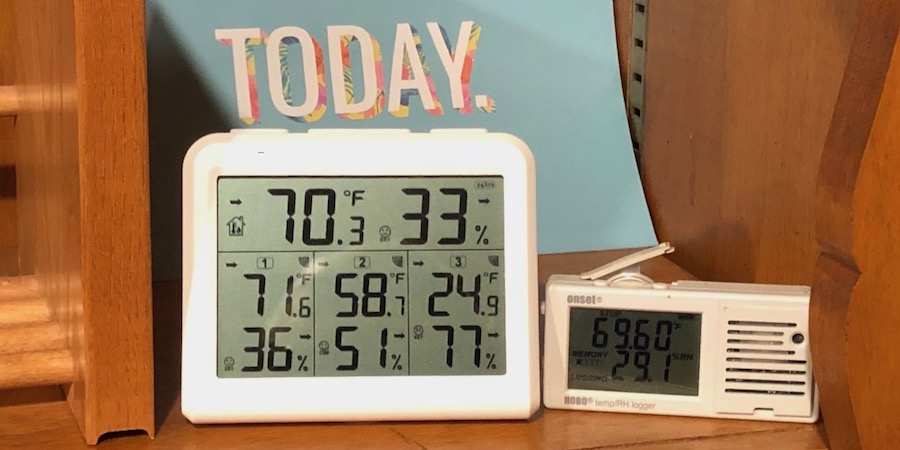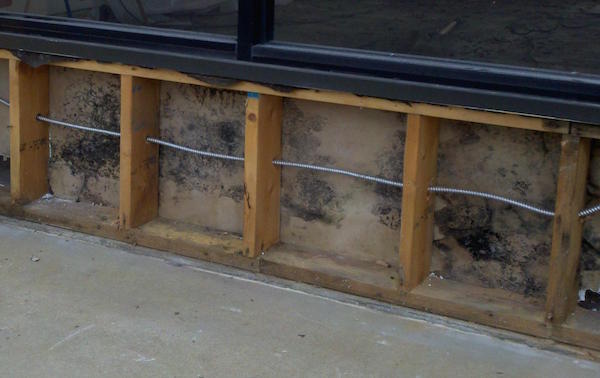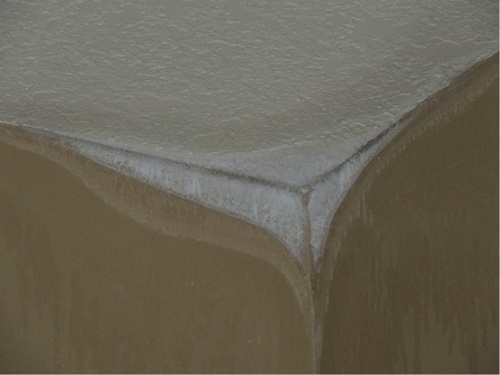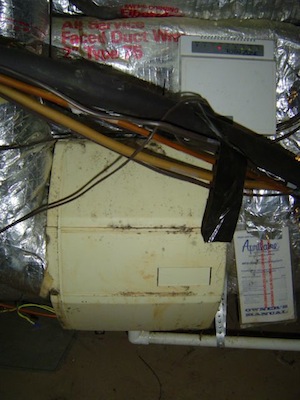What Is the Best Indoor Relative Humidity in Winter?

It’s been a little crackly around here lately. We’re having a cold spell in Atlanta, with high temperatures right around the freezing point. As a result, the indoor relative humidity has dropped and we’re getting some static electricity. Even better, what I call the Southern Lights are visible at night, too. (I’ve never called it that before, but hey, a man named Allison is entitled to make things up on the spot.) That’s when the microfiber blanket on the bed lights up every time I move.
Why is the humidity low in winter?
I’ve written about the reason for this before. Basically, it’s that cold air is dry air. The lower the temperature, the less water can exist in the vapor state. You may have a high relative humidity,* but the actual amount of water vapor in the air (sometimes called absolute humidity but better characterized by something called humidity ratio) will drop as the temperature drops.
Cold air is dry air. When that cold air outdoors comes into your home, via either infiltration or ventilation, it mixes with your indoor air. The result is less overall water vapor in the indoor air, too.
Of course, you have to consider the humidity-generating activities in the home, too. If you work from home and the bathtub is your office and you’ve got a big pot of pasta going every day, your indoor humidity may be too high, especially in an airtight home that’s not overventilated.
Anyway, just remember that cold air is dry air. The more cold, outdoor air you bring into the home, the drier the indoor air will be. If you don’t know what the relative humidity is inside your home, you can buy a digital hygrometer on Amazon. I’ve been using this hygrometer with 3 remote sensors (base unit shown on the left in the photo above) and I like it, but I plan to upgrade to this hygrometer because of its graphing ability.*
What’s the best relative humidity in winter?
Ah, such a tricky question. The standard answer in a case like this is, It depends. It depends on:
- Climate zone
- How good your building enclosure (insulation and air barrier) is
- How much moisture you generate indoors
- How much you ventilate the home
- How many times your youngest kid has complained about being shocked by the eldest (I wouldn’t know anything about that. Static electricity hadn’t been imported to the Gulf Coast when I was growing up.)
Based on what we know from the last section, the colder the climate you live in, the drier your indoor air can be. That also means that you’ll have colder surfaces that can absorb moisture. That’s when you start having problems with “accidental dehumidification,” such as condensation on your windows.
But it can be worse than that, too. You could get frost on your ceiling, like in this home:
Yikes! The problem here was cold, windy weather hitting part of the house where the insulation had blown back away from the soffit vents. (See my article on this home for more about this story.)
But hey, at least the moisture problem here is visible. It’s worse when it happens inside the walls, as in the photo below.

If you put enough water vapor in contact with cold surfaces, this is what can happen. And your really don’t want that in your walls.
First, let’s lay out a general rule for the ideal indoor relative humidity.
You want to keep the indoor relative humidity low enough to prevent visible and invisible moisture problems and high enough to prevent excess static electricity or dry skin.
On the low end, you probably don’t want to go lower than 30-35% relative humidity (RH). That’s a little dry but not too bad. Again, the colder the climate, the lower you’ll probably want that number. In a moderate climate, you might want to aim for a low end of 40%.
On the high end, if you go to 45% RH in a cold climate, you’re pushing your luck unless you have a really good building enclosure. In warmer climates, you can go higher, and you will as the weather changes, but 50% RH is a good target.
Now, having said that, if you have a really energy efficient house, say a Passive House, with a great building enclosure in a cold climate (think R-40 walls and low infiltration), you can go higher. Say 40%. Perhaps even higher. The good thing about a great enclosure is that it decouples you somewhat from the big changes that happen outdoors.
What should you do if the indoor relative humidity is too high or too low?
If the home is too dry, people often resort to installing a humidifier. I’m not going to say they’re never necessary, but if you have an airtight, well-insulated home, you almost certainly won’t need a humidifier. The internally generated moisture will usually keep the indoor conditions where you want them (unless you’re the pasta-eating bathtub entrepreneur).
If you don’t have a Passive House and the air is too dry, the first thing to do is air sealing. The leakier your house, the more of that cold, dry outdoor air you’re bringing in and the lower your indoor relative humidity will be. Seal it up and then see where you are before deciding on a humidifier. A humidifier is usually a bandaid for a leaky home.
If your relative humidity is too high in winter, yeah, you could install a dehumidifier, but there are better ways to solve the problem. (True most of the time. Sometimes you need a dehumidifier in winter.) First, take a look at the sources of water vapor you’re generating indoors. Maybe you should run that bath fan when you take a shower and turn on the range hood when you’re cooking. Also, remember that cold air is dry air. If the indoor humidity is too high, add some more ventilation air to cut the humid air with dry air.
What have you found to be the ideal indoor relative humidity in your location?
The first step with any indoor humidity problem is to measure what you’ve got. The best solution is a digital thermo-hygrometer with remote sensors so you can monitor the temperature and relative humidity is different parts of your home. Amazon sells many digital thermo-hygrometers. I’ve been using this hygrometer with 3 remote sensors and I like it, but I plan to upgrade to this hygrometer because of its graphing ability.*
Related Articles
Accidental Dehumidification – A Preventable Mess
A Humidifier Is a Bandaid — The Problem Is Infiltration
What Happens When You Put a Plastic Vapor Barrier in Your Wall?
* These are Amazon Associate links. You pay the same price you would pay normally, but Energy Vanguard makes a small commission if you buy after using our link.
Photo of frost on ceiling/wall intersection by Erik Henson of HD Engineering and Design, used with permission.
NOTE: Comments are moderated. Your comment will not appear below until approved.
This Post Has 17 Comments
Comments are closed.



The little digital
The little digital hygrometers that you can buy at the box stores, are those measuring relative humidity or absolute?
They measure relative
They measure relative humidity, Clay. They’re handy to have around and you can get inexpensive models that have 2 or 3 remote sensors so you can monitor conditions in other parts of the house, too.
Love the “Southern
Love the “Southern Nights” observation!
Would a Erv in warm climates
Would a Erv in warm climates or Hrv help with humidity inside the house envelope ?
Yes, in both cases. No, in
Yes, in both cases. No, in both cases. In other words, it depends. How humid is the home before installing it (if we’re talking about an existing home)?
One point of confusion is that an ERV doesn’t do the job of a dehumidifier. (See my article on that topic: http://bit.ly/1P5Bms8.) In winter, it will result in lower indoor humidity but will keep the home closer to the starting RH than will an HRV. If you need more drying, use an HRV. If you need only a little drying, use an ERV.
@Alejandro, in addition to
@Alejandro, in addition to what Allison said, an ERV can in some cases RAISE RH in winter, if used as primary exhaust for a high use shower. This is most likely to occur during shoulder months when weather can oscillate between periods of rain mild temperatures and cold snaps.
In warm climates, ERV’s are most useful for reducing ventilation-induced moisture in summer.
For us in Zone 7, humidifiers
For us in Zone 7, humidifiers are necessary unless the house has an air change rate less than 1 ACH. My 78 vintage house will drop to 15%-20% RH without it and that’s just too uncomfortable. The spray foam I did of the attic last year is helping quite a bit,as we can hold humidity at -17F, but the double hung windows and patio doors(although only 15 years old) let too much air in. (My kids house we built 10 years ago is airtight enough to need a humidistat controlled exhaust fan in the bathroom).
It’s because of people like
It’s because of people like you, David, that I used words like “probably” and “usually” when talking about whether you need a humidifier. Most people should be able to solve the problem with air sealing and the right amount of ventilation, but for people who live in crazy cold climates like IECC climate zone 7, it can be really hard to make the house airtight enough.
For those of you wondering, CZ 7 in the US includes northern Maine, the northernmost part of the upper Midwest, and a few places in the Rocky Mountains. Even in Canada, I believe, the majority of the population lives in CZ 6.
Great article! I’ve been
Great article! I’ve been thinking about this subject as my house runs in the teens of RH.
What temp are you assuming for RH again? Would dew point be good to add as well?
Good questions, Nate. Most
Good questions, Nate. Most people keep their homes around 70° F, and that’s what I assumed here. For those who keep it significantly cooler indoors, the chances of accidental dehumidification are greater because the surfaces are cooler.
In summer, a dew point of 55° F is what you get at 75° F and 50% RH. In winter, you get 45° F with indoor conditions of 70° F and 40% RH.
I have a ground source heat
I have a ground source heat pump system and the humidity is shown to be 25% when outside temperature is about 25 degrees. I do not have any static electricity when turning on lights or touching metal objects I live in Oklahoma in a 6,000 SF home keeping the temperature constant at 71 degrees night and day. My average cost for the total electric home is $156 per month for cooking, lights, heating, cooling and hot water. I have 6 boreholes 300′ deep with 1″ HDPE pipe, reverse return and 3 units 4 ton, 3 ton and 2 ton units with each on its own thermostats. i have no outside units making noise and the inside units sound like refrigerators when running. Home was built is 2010. Should I get a humidifier to increase humidity in the home? It is very comfortable. In the summer time when it is 100 degrees outside the humidity is usually around 50%. It is very comfortable even at 50% humidity.
Gerald, I’m surprised you don
Gerald, I’m surprised you don’t get static electricity at 25% RH. I get it at about 35% in my condo. Regarding your question about whether you should get a humidifier, I’d say if it ain’t broke, don’t break it. If you’re comfortable and don’t notice a static electricity or dry skin problem, why rock the boat?
The ideal summer humidity is a different animal. Up to 60% is fine then. If you’re getting 50%, that’s great.
Well I will stick with around
Well I will stick with around 25%-40% for most of us in colder climates with slightly cooler temps http://thehtrc.com/2015/faq-window-wall-condensation-iced
Interesting that you are getting northern lights at 35%, generally as recall it shouldn’t be happening until you are in the teens to maybe low 20’s
As for when living down south, I might say 30 to 40.
We’re in NE Ohio and keep the
We’re in NE Ohio and keep the humidity around 32% in the winter. No static at all. Last winter when it hit -5 air temp we had a little frost on the inside corner of an addition, I backed the humidity down to 10% while it was that cold. All that started me on a major air sealing of the house and adding R70 to the attic, which is mostly but not completely done.
Thanks for another great
Thanks for another great article, Allison. My wife and I live in a Passive House in West Chester, PA (about 20 miles west of downtown Philly). At the moment, our interior stats are 69 degrees and 39.3% RH. Outside, it’s 25 degrees and 88% RH. Although we seem to be at the upper limit of what is generally considered acceptable, that feels very comfortable. In the past, those numbers would have caused me to keep our ERV set to low except when showering. But I now understand why we should also be increasing the ventilation when we’re engaged in other moisture producing activities like cooking or washing clothes.
Hi guys
Hi guys
I think that RH doesn’t tell us how comfortable we live indoor. The RH is as the name said “relative” and show us a percentage of water vapor in a mass of air reported to the max amount of water vapour that mass could contain. It doesn’t tell us the amount gr/m3 or gr/kg in the air. We could have at different temperatures different RH. Isn’t it? As we heat up the air the RH will decrease. But the Quantity of moisture gr/ m3 remain the same. The absolute quantity of moisture will tell us the real absolute quantity of moisture into the air, that is Dew Point an not RH. Leet say in a summer morning we have outside 21C and RH 100% and DP 21C. It means that the air is saturated and we will see dew on the grass. During the day the air will worm up to 32C and RH 50% at the same DP of 21C. During the day even if we have the fantastic 50% RH as everybody tells is the optimum. At DP of 21C the air is very humid. The comfortable limits is between 10-15C DP. Am I right? In this case presented we have to humidify, ventilate etc our house according to DP and not RH.
@Pohl, the body responds to
@Pohl, the body responds to relative humidity, not so much to absolute humidity. So while 10-15C is indeed a comfortable dew point range indoors, that’s only true because 10-15 correlates with the comfort range for relative humidity.
Consider when you’re outdoors and it’s 35C… a dew point of 23 or even 25C will feel very nice.
Likewise, mold responds to relative humidity, not absolute humidity.
Absolute humidity is a useful metric where you have an imperfect boundary between air at different conditions, such as ventilation, infiltration and vapor drive.